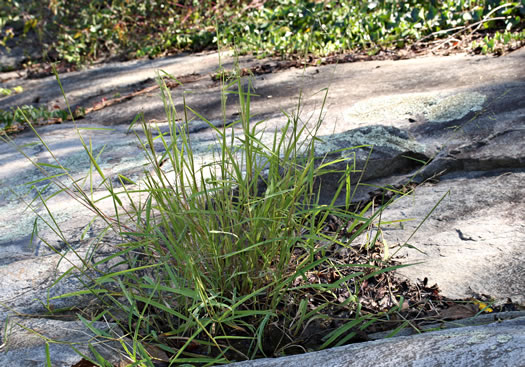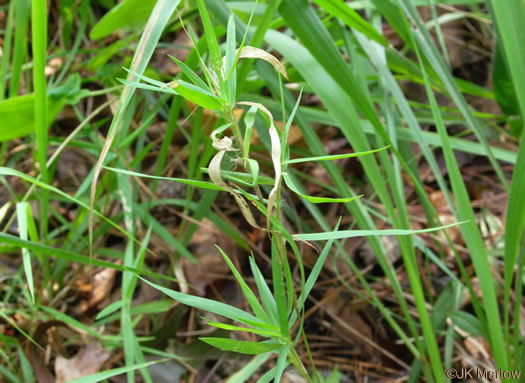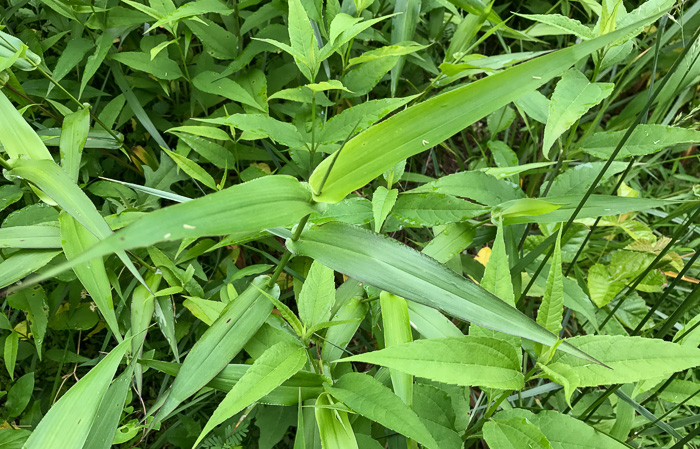Your search found 493 image(s) illustrating the term "blade." For a written explanation, click on "blade" in the Glossary.
PAGE 1 PAGE 2 PAGE 3 PAGE 4 PAGE 5 PAGE 6 PAGE 7 PAGE 8 PAGE 9
To see larger pictures, click or hover over the thumbnails.
To go to the plant's detail page, click its name.
 Sandhills Dropseed,
Sporobolus junceus
Sandhills Dropseed,
Sporobolus junceus
Leaf blades folded or involute, slender, glabrous, per Manual of the Grasses of the United States (Hitchcock & Chase, 1950).
 West Indian Dropseed,
Sporobolus jacquemontii
West Indian Dropseed,
Sporobolus jacquemontii
Culms 40-100cm. Blades 10-40cm long, 2-4mm wide, tapering to a fine point, per Grass Manual on the Web.
 Nuttall's Reedgrass,
Greeneochloa coarctata
Nuttall's Reedgrass,
Greeneochloa coarctata
Sheaths and blades scabrous, rarely sparsely hirsute, per The Grasses of North Carolina (Blomquist, 1948).
 Nuttall's Reedgrass,
Greeneochloa coarctata
Nuttall's Reedgrass,
Greeneochloa coarctata
Leaf blades flat, per The Grasses of North Carolina (Blomquist, 1948).
 Goosegrass,
Eleusine indica
Goosegrass,
Eleusine indica
Leaf blades to 2dm long, glabrous or sparsely pilose above, glabrous beneath, per Vascular Flora of the Carolinas (Radford, Ahles, & Bell, 1968).
 Bermuda Grass,
Cynodon dactylon
Bermuda Grass,
Cynodon dactylon
Old bladeless sheaths of the stolon often forming conspicuous "dog's teeth", per Manual of the Grasses of the United States (Hitchcock & Chase, 1950).
 Bermuda Grass,
Cynodon dactylon
Bermuda Grass,
Cynodon dactylon
Leaf blades flat, those of the basal offshoots often conspicously 2-ranked, per Manual of the Grasses of the United States (Hitchcock & Chase, 1950).
 Red Sprangletop,
Dinebra panicea ssp. brachiata
Red Sprangletop,
Dinebra panicea ssp. brachiata
Leaf blades flat, thin, as much as 1cm wide, per Manual of the Grasses of the United States (Hitchcock & Chase, 1950).
 Eastern Skeletongrass,
Gymnopogon ambiguus
Eastern Skeletongrass,
Gymnopogon ambiguus
Leaves numerous, approximate with overlapping sheaths, blades spreading, per Manual of the Grasses of the United States (Hitchcock & Chase, 1950).
 Saltmarsh Cordgrass,
Spartina alterniflora
Saltmarsh Cordgrass,
Spartina alterniflora
Leaves cauline; sheaths overlapping; blades usually < 12mm wide, per Vascular Flora of the Carolinas (Radford, Ahles, & Bell, 1968).
 Catchfly Cutgrass,
Leersia lenticularis
Catchfly Cutgrass,
Leersia lenticularis
Blades lax, 1-2cm wide. Panicle open; spikelets closely imbricate, per Manual of the Grasses of the United States (Hitchcock & Chase, 1950).
 White Cutgrass,
Leersia virginica
White Cutgrass,
Leersia virginica
Leaf blades relatively short, 6-12mm wide, per Manual of the Grasses of the United States (Hitchcock & Chase, 1950).
 Rice Cutgrass,
Leersia oryzoides
Rice Cutgrass,
Leersia oryzoides
Sheaths and blades strongly retrorsely scabrous, blades mostly 8-10mm wide, per Manual of the Grasses of the United States (Hitchcock & Chase, 1950).
 Southern Wild-rice,
Zizaniopsis miliacea
Southern Wild-rice,
Zizaniopsis miliacea
Leaf blades glabrous except very scabrous margins, 1-2cm wide, midrib stout, per Manual of the Grasses of the United States (Hitchcock & Chase, 1950).
 Pinebarrens Peanut-grass,
Amphicarpum amphicarpon
Pinebarrens Peanut-grass,
Amphicarpum amphicarpon
Leaf blades hirsute on both surfaces, margins ciliate; sheaths hirsute, per Vascular Flora of the Carolinas (Radford, Ahles, & Bell, 1968).
 Pinebarrens Peanut-grass,
Amphicarpum amphicarpon
Pinebarrens Peanut-grass,
Amphicarpum amphicarpon
Leaf blade surfaces hirsute with pustular-based hairs, margins ciliate, per Weakley's Flora.
 Dune Sandbur,
Cenchrus tribuloides
Dune Sandbur,
Cenchrus tribuloides
Leaf sheaths inflated, the blades usually folded, per Wildflowers of the Eastern United States (Duncan & Duncan, 1999).
 Rough Barnyard-grass,
Echinochloa muricata var. muricata
Rough Barnyard-grass,
Echinochloa muricata var. muricata
Sheaths glabrous, blades elongate, 5-15mm wide, per Manual of the Grasses of the United States (Hitchcock & Chase, 1950).
 Vasey Grass,
Paspalum urvillei
Vasey Grass,
Paspalum urvillei
Leaf blades 3-15mm wide, pilose at base, per Manual of the Grasses of the United States (Hitchcock & Chase, 1950).
 Redtop Panicgrass,
Coleataenia rigidula ssp. rigidula
Redtop Panicgrass,
Coleataenia rigidula ssp. rigidula
Leaf blades erect, folded at base, flat above, 20-50cm long, 5-12mm wide, per Manual of the Grasses of the United States (Hitchcock & Chase, 1950).
 Seaside Panicum,
Panicum amarum var. amarum
Seaside Panicum,
Panicum amarum var. amarum
Leaf blades 20-50cm long, 5-12mm wide, more or less involute, per Manual of the Grasses of the United States (Hitchcock & Chase, 1950).
 Old-witch Panicgrass,
Panicum capillare
Old-witch Panicgrass,
Panicum capillare
Blades 10-25cm long, 5-15mm wide, hispid on both surfaces; sheaths hispid, per Manual of the Grasses of the United States (Hitchcock & Chase, 1950).
 Starved Witchgrass,
Dichanthelium depauperatum
Starved Witchgrass,
Dichanthelium depauperatum
Vernal phase with culms several to many in a tuft. Leaf blades 6-15cm x 2-5mm, per Manual of the Grasses of the United States (Hitchcock & Chase, 1950).
 Open-flower Witchgrass,
Dichanthelium laxiflorum
Open-flower Witchgrass,
Dichanthelium laxiflorum
Leaf blades soft and not stiff (lax, thus the scientific and common names), per Forest Plants of the Southeast and Their Wildlife Uses (Miller & Miller, 2005).
 Open-flower Witchgrass,
Dichanthelium laxiflorum
Open-flower Witchgrass,
Dichanthelium laxiflorum
Autumnal blades scarcely reduced, much exceeding the secondary panicles, per Manual of the Grasses of the United States (Hitchcock & Chase, 1950).
 Dwarf Witchgrass,
Dichanthelium strigosum var. leucoblepharis
Dwarf Witchgrass,
Dichanthelium strigosum var. leucoblepharis
Leaf blades ciliate with stiff hairs 2-3mm long, per Manual of the Grasses of the United States (Hitchcock & Chase, 1950).
 Hairless Witchgrass,
Dichanthelium strigosum var. glabrescens
Hairless Witchgrass,
Dichanthelium strigosum var. glabrescens
Culms glabrous, blades conspicuously ciliate, per Manual of the Grasses of the United States (Hitchcock & Chase, 1950).
 Sandy Woods Witchgrass,
Dichanthelium arenicoloides
Sandy Woods Witchgrass,
Dichanthelium arenicoloides
Larger autumnal blades to 6cm by 1.5mm, involute, per Weakley's Flora (2015).
 Ravenel's Witchgrass,
Dichanthelium ravenelii
Ravenel's Witchgrass,
Dichanthelium ravenelii
Blades thick, upper surface glabrous, densely velvety-hirsute beneath, per Manual of the Grasses of the United States (Hitchcock & Chase, 1950).
 Few-flowered Witchgrass,
Dichanthelium oligosanthes
Few-flowered Witchgrass,
Dichanthelium oligosanthes
Blades stiffly spreading or ascending, 6-14cm long, 5-8mm wide, per Manual of the Grasses of the United States (Hitchcock & Chase, 1950).
 Few-flowered Witchgrass,
Dichanthelium oligosanthes
Few-flowered Witchgrass,
Dichanthelium oligosanthes
Blade upper surface glabrous or nearly so, harshly puberulent beneath, per Manual of the Grasses of the United States (Hitchcock & Chase, 1950).
 Woolly Witchgrass,
Dichanthelium acuminatum var. acuminatum
Woolly Witchgrass,
Dichanthelium acuminatum var. acuminatum
Blades thickish but not stiff, somewhat incurved when fresh, per Manual of the Grasses of the United States (Hitchcock & Chase, 1950).
 White-haired Witchgrass,
Dichanthelium villosissimum var. villosissimum
White-haired Witchgrass,
Dichanthelium villosissimum var. villosissimum
Blades rather firm, 6-10cm x 5-10mm, pilose on both surfaces, per The Grasses of North Carolina (Blomquist, 1948).
 White-haired Witchgrass,
Dichanthelium villosissimum var. villosissimum
White-haired Witchgrass,
Dichanthelium villosissimum var. villosissimum
The lower margins of each leaf blade are ciliate with long white hairs, per www.illinoiswildflowers.info.
 White-haired Witchgrass,
Dichanthelium villosissimum var. villosissimum
White-haired Witchgrass,
Dichanthelium villosissimum var. villosissimum
... and the width of its vernal leaf blades (4-10mm across), per www.illinoiswildflowers.info.
 Forked Witchgrass,
Dichanthelium dichotomum var. dichotomum
Forked Witchgrass,
Dichanthelium dichotomum var. dichotomum
Spikelets glabrous, 1.8-2.3mm long; widest vernal blades 3-8(10)mm wide, per Weakley's Flora (2020).
 Forked Witchgrass,
Dichanthelium dichotomum var. dichotomum
Forked Witchgrass,
Dichanthelium dichotomum var. dichotomum
Autumnal phase much branched at middle nodes, lower part usually bladeless, per Manual of the Grasses of the United States (Hitchcock & Chase, 1950).
 Small-fruited Witchgrass,
Dichanthelium microcarpon
Small-fruited Witchgrass,
Dichanthelium microcarpon
... having wider vernal leaf blades (7-15mm wide vs. 3-8mm wide), per Vascular Plants of North Carolina.
 Small-fruited Witchgrass,
Dichanthelium microcarpon
Small-fruited Witchgrass,
Dichanthelium microcarpon
Leaf blades spreading, 10-12cm long, averaging 10mm wide, per The Grasses of North Carolina (Blomquist, 1948).
 Long-ligule Witchgrass,
Dichanthelium longiligulatum
Long-ligule Witchgrass,
Dichanthelium longiligulatum
Culms 2-7dm long, wiry. Leaf blades glabrous, to 8cm long, 2-6mm wide, per Vascular Flora of the Carolinas (Radford, Ahles, & Bell, 1968).
 Erectleaf Witchgrass,
Dichanthelium erectifolium
Erectleaf Witchgrass,
Dichanthelium erectifolium
Leaf blades 7-14cm long, 6-12mm wide, per Manual of the Grasses of the United States (Hitchcock & Chase, 1950).
 Many-flowered Witchgrass,
Dichanthelium polyanthes
Many-flowered Witchgrass,
Dichanthelium polyanthes
blades relatively long, spreading to ascending, the upper slightly reduced, per The Grasses of North Carolina (Blomquist, 1948).
 Many-flowered Witchgrass,
Dichanthelium polyanthes
Many-flowered Witchgrass,
Dichanthelium polyanthes
Blades glabrous on both surfaces, per Vascular Flora of the Carolinas (Radford, Ahles, & Bell, 1968).
 Many-flowered Witchgrass,
Dichanthelium polyanthes
Many-flowered Witchgrass,
Dichanthelium polyanthes
Leaf blades firm, white-margined, conspicuously striate, per The Grasses of North Carolina (Blomquist, 1948).
 Many-flowered Witchgrass,
Dichanthelium polyanthes
Many-flowered Witchgrass,
Dichanthelium polyanthes
Mid-culm blades to 25cm long, 14-30mm wide, the uppermost 10-15+ cm long, per Weakley's Flora (2020).
 Velvet Witchgrass,
Dichanthelium scoparium
Velvet Witchgrass,
Dichanthelium scoparium
Leaf blades rather thick, 12-20cm long, 10-18mm wide, per Manual of the Grasses of the United States (Hitchcock & Chase, 1950).
 Velvet Witchgrass,
Dichanthelium scoparium
Velvet Witchgrass,
Dichanthelium scoparium
A viscid band below the retrorsely bearded nodes; internodes, sheaths, blades velvety-pubescent, per Weakley's Flora (2022).
 Variable Witchgrass,
Dichanthelium commutatum +
Variable Witchgrass,
Dichanthelium commutatum +
Blades glabrous, margins scaberulose, bases cordate, frequently ciliate, per Vascular Flora of the Carolinas (Radford, Ahles, & Bell, 1968).
 Deer-tongue Witchgrass,
Dichanthelium clandestinum
Deer-tongue Witchgrass,
Dichanthelium clandestinum
Blades spreading or finally reflexed, 10-20cm long, 1.2-3cm wide, per Manual of the Grasses of the United States (Hitchcock & Chase, 1950).
 Deer-tongue Witchgrass,
Dichanthelium clandestinum
Deer-tongue Witchgrass,
Dichanthelium clandestinum
Blades glabrous both surfaces, margins scaberulose, bases cordate, ciliate, per Vascular Flora of the Carolinas (Radford, Ahles, & Bell, 1968).
 Bosc's Witchgrass,
Dichanthelium boscii
Bosc's Witchgrass,
Dichanthelium boscii
Var. molle difers in its velvety blades and downy-villous culms and sheaths, per Manual of the Grasses of the United States (Hitchcock & Chase, 1950).
 Bosc's Witchgrass,
Dichanthelium boscii
Bosc's Witchgrass,
Dichanthelium boscii
... Bosc's leaf blades are wider (over 1") than Ravenel's (¾" or less), per www.illinoiswildflowers.info.
 Bosc's Witchgrass,
Dichanthelium boscii
Bosc's Witchgrass,
Dichanthelium boscii
Blades glabrous, puberulent or pilose on both surfaces, per Vascular Flora of the Carolinas (Radford, Ahles, & Bell, 1968).
 Bosc's Witchgrass,
Dichanthelium boscii
Bosc's Witchgrass,
Dichanthelium boscii
Blade margins scaberulose, bases cordate, long-ciliate, per Vascular Flora of the Carolinas (Radford, Ahles, & Bell, 1968).
 Itch-grass,
Rottboellia cochinchinensis
Itch-grass,
Rottboellia cochinchinensis
Leaf blades flat, in robust specimens to 3cm wide, per Manual of the Grasses of the United States (Hitchcock & Chase, 1950).
 Silver Plumegrass,
Erianthus alopecuroides
Silver Plumegrass,
Erianthus alopecuroides
Leaf blade pilose on upper surface toward the base, per Manual of the Grasses of the United States (Hitchcock & Chase, 1950).
 Bent-awn Plumegrass,
Erianthus contortus
Bent-awn Plumegrass,
Erianthus contortus
Blades 1-1.5cm wide, scabrous, per Manual of the Grasses of the United States (Hitchcock & Chase, 1950).
 Rose Natalgrass,
Melinis repens ssp. repens
Rose Natalgrass,
Melinis repens ssp. repens
Leaf sheaths loose; leaf blades linear, to 20 x 0.2-1.4cm, per Flora of China.
 Common Little Bluestem,
Schizachyrium scoparium
Common Little Bluestem,
Schizachyrium scoparium
Leaf blades linear, 8-14" long at maturity, initially light green, per Wildflowers & Plant Communities of the Southern Appalachian Mountains and Piedmont (Spira, 2011).
 Big Bluestem,
Andropogon gerardi
Big Bluestem,
Andropogon gerardi
Plant bluish-green, tufted, erect, often glaucous. Lf blades ~ 0.2-0.4" wide, per Wildflowers of Tennessee (Carman, 2005).




























































